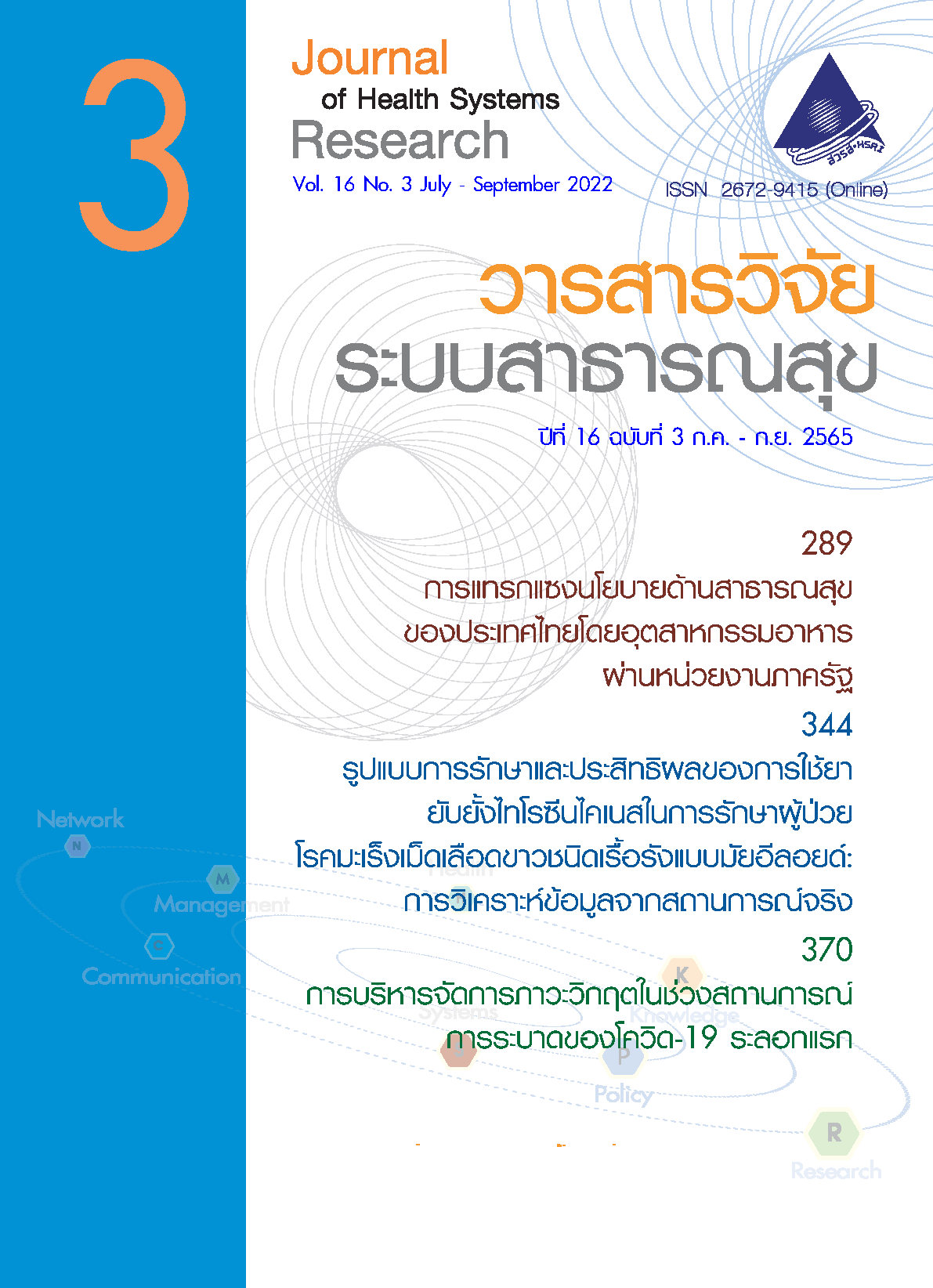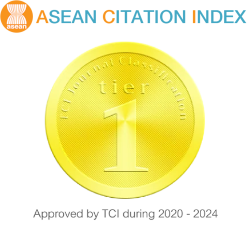Model Development Using “Healthier Choice” Nutrition Symbol for Promoting Health of Noodle Consumers in Mueang Lampang District
Keywords:
healthier choice, nutrition symbol, sodium salts, noodle shopAbstract
The aims of this research and development were to 1) develop a model and 2) study the effectiveness of using the healthier choice nutrition symbol in noodle shops, Mueang Lampang district, Lampang province. The research process consisted of 4 steps: 1) analyze, assess needs by in-depth interview with relevant parties (R1). 2) Design and develop of a model by adjusting the noodle soup recipe using low sodium seasonings to replace the original seasonings (D1). 3) The experimental model consisted of guidelines for adjusting soup recipes, how to cook soup, measurement of sodium salt content in the soup, placement of healthier choice nutrition symbol seasonings in the shop (R2), then assessing knowledge, attitudes, and behaviors on healthier choice nutrition symbol and sodium salt content in noodle soup in the experiment group, assessing satisfaction on new noodle soup recipe with 16 purposively selected experiment samples. Data were collected by using a questionnaire and an in-depth interview. 4) The evaluations on knowledge, attitude, behavior, sodium content in soup and post-satisfaction were undertaken to improve the final optimal soup recipe (D2) using content analysis from group discussions.
The results found that: step 1, noodle shop owners realized the need to reduce the use of sodium salt in soup. Step 2, developed new soup recipe using soy sauce containing potassium chloride to replace the original sodium salt. Cooking manual was developed as guidelines explaining new recipes, how to cook soup, measuring the amount of sodium salt and placement of extra seasonings in a noodle shop. Step 3, after serving new soup recipe, the noodle shop owners gained better knowledge, attitude and behavior, with reduced sodium consumption. They were satisfied at the highest level. Step 4: The evaluations revealed that the amount of sodium salt use decreased from the daily measurement. However, the present study was just a pilot scale with small sample size. The model should be extended to a larger population for more reliable results.
References
Pitisutti S. Acceptance of social media to improve street food business in the Bangkok metropolitan area. An independent study submitted in partial fulfillment of the requirement for the degree of master of business administration, faculty of commerce and accountancy. Bangkok: Thammasat University; 2018.
Apinya T. Strategy to reduce salt and sodium consumption in Thailand 2016-2025. Bangkok: War Veterans Organization of Thailand under royal patronage; 2016.
Kerdphoka P. Situation of health problems of Thai people from consuming salt (sodium). 2019 [cited 2019 Apr 30]. Available from: https://oryor.com/media/infoGraphic/media_printing/1767. (in Thai)
Mekhora C, Vattanasuchart N. Sodium reduction: health role, strategy and research for food product reformulation. Journal of Nutrition Association of Thailand. 2020;55(1):111-30.
Thai Health Reform Foundation. Thai people are addicted to salt from local culture. cause more than 20,000 deaths per year. 2019. [cited 2019 Mar 20]. Available from: https://www.hfocus.org/content/2019/04/17106. (in Thai)
Consumer Protection Group, Lampang Provincial Public Health Office. Interview report of entrepreneur noodle shop in Lampang province. Lampang: Provincial Public Health Office; 2020.
Clark D. Instructional system design-analysis phase. Computing in Childhood Education 2003;1:3-27.
Best W. and Kahn V. Research in education. 8th Edition. Chicago: Butler University, Emeritus, University of Illinois; 1998.
Creswell JW. Research design: qualitative, quantitative, and mixed methods approaches. 4th ed. Thousand Oaks, California: SAGE Publications; 2014.
Thai Health Promotion Foundation. Development and promotion project, simple nutrition symbol. 2016 [cited 2016 Dec 13]. Available from: http://healthierlogo.com. (in Thai)
Mekhora C, Vattanasuchart N. Sodium reduction: health role, strategy and research for food product reformulation. Journal of Nutrition Association of Thailand. 2020;55(1):111-30. (in Thai)
Grummer J, Bobowski N, Karalus M, Vickers Z, Schoenfuss T. Use of potassium chloride and flavor enhancers in low sodium Cheddar cheese. J Dairy Sci. 2013;96(3):1401-18.
Horita CN, Esmerino EA, Vidal VAS, Farah JS, Amaral GV, Bolini HMA, et al. Sensory profiling of low sodium frankfurter containing garlic products: adequacy of polarized projective mapping compared with trained panel. Meat Sci. 2017;131:90-8.
Paulsen MT, Nys A, Kvarberg R, Hersleth M. Effects of NaCl substitution on the sensory properties of sausages: temporal aspects. Meat Sci. 2014;98(2):164-70.
Wu H, Zhang Y, Long M, Tang J, Yu X, Wang J, et al. Proteolysis and sensory properties of dry-cured bacon as affected by the partial substitution of sodium chloride with potassium chloride. Meat Sci. 2014;96(3):1325-31.
Rodrigues JF, Goncalves CS, Pereira RC, Carneiro JD, Pinheiro AC. Utilization of temporal dominance of sensations and time intensity methodology for development of low-sodium mozzarella cheese using a mixture of salts. J Dairy Sci. 2014;97(8):4733-44.
Ma GX, Shive S, Zhang Y, Aquilante J, Tan Y, Zhao M,et al. Knowledge, perceptions, and behaviors related to salt use among Philadelphia Chinese take-out restaurant owners and chefs. Health Promotion Practice. 2014;15(5):638-45.
Suon M, Ruaisungnoen W. Health literacy on sodium restriction and associated factors among patients with hypertension in Phnom Penh, Cambodia. Nursing Science Journal of Thailand. 2019;37(4):32-41. (in Thai)
Bureau of Non-Communicable Diseases, Department of Disease Control, Ministry of Public Health. Strategy to reduce salt and sodium consumption in Thailand 2016-2025. Bangkok; 2016 [cited 2019 Jan 5 ]. Available from: https://thaidj.org/index.php/jdhss/article/view/6310.
Escaron AL, Martinez-Donate AP, Riggall AJ, Meinen A, Hall B, Nieto FJ, et al. Developing and Implementing “Waupaca Eating Smart”: a restaurant and supermarket intervention to promote healthy eating through changes in the food environment. Health Promotion Practice. 2016;17(2):265-77.
Chau PH, Leung AYM, Li HLH, Sea M, Chan R, Woo J. Development and validation of Chinese health literacy scale for low salt consumption - Hong Kong population (CHLSalt-HK). PLoS ONE. 2015:10(7):e0132303. doi: 10.1371/journal.pone.0132303.
Downloads
Published
How to Cite
Issue
Section
License
Copyright (c) 2025 Journal of Health Systems Research

This work is licensed under a Creative Commons Attribution-NonCommercial-NoDerivatives 4.0 International License.
Journal of Health Systems Research is licensed under a Creative Commons Attribution-NonCommercial-NoDerivatives 4.0 International (CC BY-NC-ND 4.0) license, unless otherwise stated.




